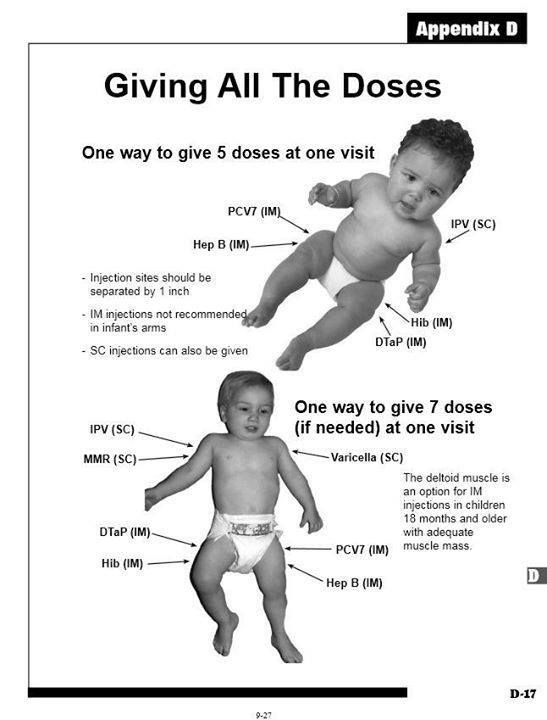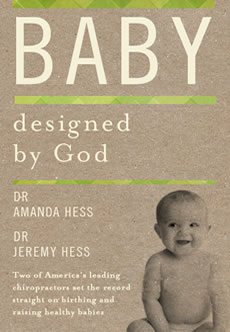
Page from a pediatrician manual showing how to give multiple vaccines to babies in one office visit.
131 Ways For An Infant to Die
by Neil Z. Miller
GreenMedInfo.com
Excerpts:
There are 130 official ways for an infant to die. These official categories of death, sanctioned by the Centers for Disease Control and Prevention (CDC) and the World Health Organization (WHO), are published in the International Classification of Diseases (ICD). When a baby dies, coroners must choose from among these 130 categories.
The official causes of death listed in the ICD include nearly every imaginable — and tragic — possibility. However, there is NO category for infant deaths caused by vaccines. This is odd because the federal government is aware that vaccines permanently disable and kill some babies — the very reason Congress established a “death and disability” tax on childhood vaccines more than 25 years ago when the National Childhood Vaccine Injury Act of 1986 (Public Law 99-660) created the National Vaccine Injury Compensation Program (VICP).
Many parents don’t realize that when they purchase vaccines for their babies, the cost is taxed and the money goes into a special fund to compensate them if and when those vaccines seriously injure or kill their babies. As of June 2014, $2.7 billion was granted for thousands of injuries and deaths caused by vaccines. Numerous cases are still pending. Awards were issued for permanent injuries such as learning disabilities, seizure disorders, mental retardation, paralysis, and numerous deaths, including many that were initially misclassified as sudden infant death syndrome (SIDS).
Since vaccine-related deaths are officially recognized by the federal government but there is NO official classification for vaccine-related deaths in the ICD, two important questions must be asked:
- Are some deaths that are listed within the 130 infant mortality death categories really deaths that are associated with vaccination?
- Are some vaccine-related deaths hidden within the death tables?
Sudden Infant Death Syndrome (SIDS)
Prior to the introduction of organized vaccination programs, “crib death” was so rare that it was not mentioned in infant mortality statistics. In the United States, national immunization campaigns were initiated in the 1960s when several new vaccines were introduced and promoted. For the first time in history, most U.S. infants were required to receive several doses of DPT (diphtheria, pertussis, tetanus), polio, and measles vaccines. By 1969, an alarming epidemic of sudden unexplained infant deaths impelled researchers to create a new medical term — sudden infant death syndrome (SIDS). By 1972, SIDS had become the leading cause of post-neonatal mortality (deaths of infants from 28 days to one year old) in the United States. In 1973, the National Center for Health Statistics, operated by the CDC, created a new cause-of-death category to document deaths due to SIDS.
SIDS is defined as the sudden and unexpected death of an infant which remains unexplained after a thorough investigation, including performance of an autopsy and review of the clinical history. Although there are no specific symptoms associated with SIDS, an autopsy often reveals congestion and edema of the lungs and inflammatory changes in the respiratory system.
In 1984, Congress held a hearing on vaccine safety. The suspected link between vaccines and sudden infant deaths was addressed. The following excerpt is from a statement made by a distraught grandmother testifying before the Congressional Committee on Labor and Human Resources:
My name is Donna Gary. I am a constituent of Senator Kennedy’s from Massachusetts. Our family should have celebrated our very first granddaughter’s first birthday last month. Instead, we will commemorate the anniversary of her death at the end of this month.
Our granddaughter, Lee Ann, was just 8 weeks old when her mother took her to the doctor for her routine checkup. That included, of course, her first DPT inoculation and oral polio vaccine. In all her entire 8 weeks of life this lovable, extremely alert baby had never produced such a blood-curdling scream as she did at the moment the shot was given. Neither had her mother ever before seen her back arch as it did while she screamed. She was inconsolable. Even her daddy could not understand Lee Ann’s uncharacteristic screaming and crying.
Four hours later, Lee Ann was dead. “Crib death,” the doctor said — “SIDS.”
“Could it be connected to the shot?” her parents implored.
“No.”
“But she just had her first DPT shot this afternoon. Could there possibly be any connection to it?”
“No, no connection at all,” the emergency room doctor said definitely.
My husband and I hurried to the hospital the following morning after Lee Ann’s death to talk with the pathologist before the autopsy. We wanted to make sure he was alerted to her DPT inoculation such a short time before her death — just in case there was something else he could look for to make the connection. He was unavailable to talk with us. We waited two-and-a-half hours. Finally, we got to talk to another doctor after the autopsy had been completed. He said it was SIDS.
In the months before Lee Ann was born, I regularly checked with a friend as to the state of her grandchild’s condition. He is nearly a year-and-a-half older than Lee Ann. On his first DPT shot he passed out cold for 15 minutes, right in the pediatrician’s office.
“Normal reaction for some children,” the pediatrician reassured. The parents were scared, but they knew what a fine doctor they had. They trusted his judgment. When it was time for the second shot, they asked “Are you sure it’s alright? Is it really necessary?” Their pediatrician again reassured them. He told them how awful it was to experience, as he had, one of his infant patient’s bout with whooping cough. That baby had died. They gave him his second DPT shot that day. He became brain-damaged.
This past week I had an opportunity to read through printed copies of the hearings of this committee. I am dismayed to learn that this same talk has been going on for years, and nothing has seemed to progress to incorporate what seems so obvious and necessary to keep from destroying any more babies, and to compensate financially those who have already been damaged for life. How accurate are our statistics on adverse reactions to vaccines when parents have been told, are still being told, “No connection to the shot, no connection at all.”?
What about the mother I have recently talked with who has a 4-year-old brain-damaged son? On all three of his DPT shots he had a convulsion in the presence of the pediatrician. “No connection,” the pediatrician assured.
I talked with a father in a town adjoining ours whose son died at the age of 9 weeks, several months before our own granddaughter’s death. It was the day after his DPT inoculation. “SIDS” is the statement on the death certificate.
Are the statistics that the medical world loves to quote to say, “There is no connection,” really accurate, or are they based on poor diagnoses, poor record keeping? What is being done to provide a safer vaccine? Who is overseeing? Will it be the same scientists and doctors who have been overseeing in the past? How much longer does the public have to wait? How are physicians and clinics going to be held accountable to see that parents are informed of the possible reactions? And how are those children who should not receive the vaccine to be identified before they are damaged — or dead?
Today is the National Day of Prayer. My prayer is that this committee be instrumental in doing what needs to be done — and soon. May there not be yet another year pass by with more children afflicted, and some dead, because those who can do so refuse to make the right connection.
Throughout the 1980s, sudden infant deaths continued to skyrocket. Parental concerns about an apparent link between childhood vaccines and SIDS reached a fever pitch. Many parents were afraid to vaccinate their babies. Authorities sought to reassure parents that vaccines are safe and claimed that sudden unexplained infant deaths following vaccines were merely coincidental.
More Vaccine Fatalities – Hidden in the Death Tables
“SIDS,” “suffocation in bed,” and death due to “unknown and unspecified causes,” are just three of the 130 official cause-of-death categories that might be concealing fatalities that were really caused by vaccination. Several other ICD categories are possible candidates for incorrect infant death classifications: unspecified viral diseases, diseases of the blood, diseases of the nervous system, unspecified diseases of the respiratory system, and shaken baby syndrome. All of these official categories may be repositories of vaccine-related infant deaths reclassified as common fatalities.
For example, a vaccine against rotavirus-induced diarrhea (Rotarix) was licensed by the Food and Drug Administration (FDA) in 2008. However, in a clinical study that evaluated the safety of this vaccine, vaccinated babies died at a significantly higher rate than non-vaccinated babies — mainly due to a statistical increase in pneumonia fatalities. (One biologically plausible explanation is that natural rotavirus infection might have a protective effect against respiratory infection.) Although these deaths appear to be vaccine related, coroners are likely to have misclassified them as pneumonia.
Some infant fatalities that occur shortly after vaccinations are incorrectly classified as shaken baby syndrome. Retinal and subdural bleeding can result from an adult that shook the baby or from vaccine damage. Expert testimony by medical practitioners has exonerated innocent parents of all charges against them. This is just another example of how the true cause of death can be reclassified or hidden within the death tables.
The practice of reclassifying ICD data greatly concerns the CDC “because inaccurate or inconsistent cause-of-death determination and reporting hamper the ability to monitor national trends, ascertain risk factors, and design and evaluate programs to prevent these deaths.” Thus, medical certification practices need to be monitored to determine how often vaccine-related infant deaths are being reclassified as ordinary mortality in the ICD. More importantly, parents need to be warned that vaccine safety is grossly overestimated when vaccine-related deaths are not being accurately documented.
Vaccine Safety, Informed Consent and Human Rights
There are 130 official ways for an infant to die (as categorized in the ICD), and one unofficial way for an infant to die: following an adverse reaction to one or more vaccines. When vaccine-related deaths are hidden within the death tables, parents are denied the ability to ascertain honest vaccine risk-to-benefit ratios, and true informed consent to vaccinations is not possible. When families are urged to vaccinate their children without access to accurate data on vaccine-related deaths, their human rights have been violated. Medical health authorities, pediatricians, and the vaccine industry then become criminal accomplices to each infant death caused by vaccines — even when vaccines are not officially acknowledged as the cause of death. Finding ways to increase vaccine safety, providing families with true informed consent, and preserving human rights must be the top priorities.
Read the Full Article along with References here.
See Also:
Why Vaccine Promoters Believe a Baby Can Receive 10,000 Vaccines
Baby designed by God
by Dr. Amanda Hess & Dr. Jeremy Hess
FREE Shipping Available!





